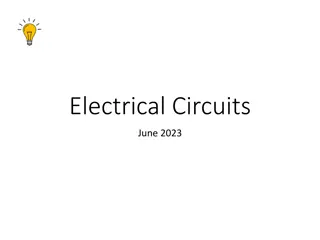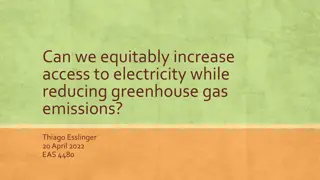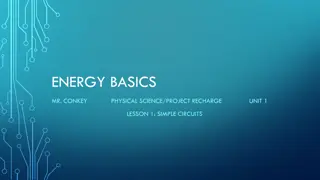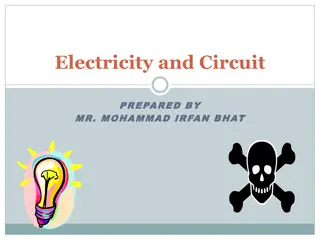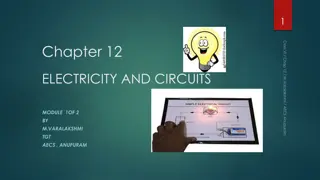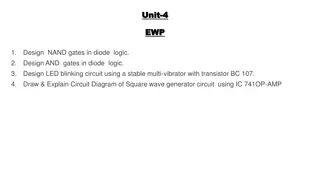Understanding Electricity and Circuits: Practical Insights
Explore the fundamentals of electricity and circuits, covering topics such as Ohm's Law, resistance, examples of resistance calculations, internal resistance in devices, power consumption, and efficiency calculations in electrical systems. Gain a deeper understanding of key concepts through practical examples and illustrations.
Download Presentation

Please find below an Image/Link to download the presentation.
The content on the website is provided AS IS for your information and personal use only. It may not be sold, licensed, or shared on other websites without obtaining consent from the author. Download presentation by click this link. If you encounter any issues during the download, it is possible that the publisher has removed the file from their server.
E N D
Presentation Transcript
Electricity and Circuits 1 Practical Session
Ohms Law Current: movement of charged particles in a specified direction Voltage: electric pressure that causes current to flow Resistance: opposition a material offers to current ?????????? ? =??????????? ? ????? (?) ???? (?) Resistivity: the characteristic resistance a material Temperature Coefficient: change in resistance corresponding to a change in temperature (Rider, 2012)
Resistance Type of material (K) Length (L) Cross-sectional area of material (A) Temperature For a specific material and temperature, this block has a given amount of resistance. Doubling the length of the block, Doubling the cross-sectional area, doubles the resistance. halves the resistance.
Examples What is the resistance, at 20 C, of a 200 m cable that connects a pv array to a the grid with a cross-sectional area of 0.26 cm2 K = 0.00000172 /cm L = 200 m or 20,000 cm A = 0.26 cm2 0.00000172 ?? 20,000 ?? 0.26 ??2 ?????????? ? = 0.132 ?????????? ? =
Examples A panel produces 12 volts output with 20 amps as sensed by the charge controller What is the resistance? V = 12 V I = 20 A ? =? ? ? = 20 ???? R = 0.6 12 ?????
Examples A 120 V air conditioning unit draws 12 amps. What is the internal resistance of the device? V = 120 V I = 12 A ? =? ? ? =120 ????? 12 ???? R = 10
Examples A 120 V air conditioning unit draws 12 amps. What is the power draw of the device? V = 120 V I = 12 A P= ? ? ? = 120 ? 12 ? P = 1440 watts
Efficiency The ratio of useful energy out compared to the total energy in %?????????? =?????? ?????? ??? ????? ?????? ?? It is a unitless value %?????????? =???? ??? 100 100
Example What is the efficiency of a 165 W panel that receives 1000 W of irradiance Useful energy out = 165 W Total energy in = 1000 W %?????????? =?????? ?????? ??? ????? ?????? ?? = 1000 W 100 = 16.5% 100 165 W
Example An experimental panel has an efficiency of 34%. What is the output if there is 800 watts of irradiance? Total energy in = 800 W = 34% %?????????? =?????? ?????? ??? ????? ?????? ?? 100 800 W = ?????? ?????? ??? Useful energy out = 272 W 100 34%
Power Rate of energy consumption/converted ????? ? =??????(?) ????(?) 1 watt = 1 joule/second W = power
Example A solar panel produced 3000 joules in 10 seconds What was the power output of the panel Given: Energy = 3000 joules Time = 10 seconds Power = energy/time W =3000 ?????? 10 ??????? W = 300 ????? ?? 0.3??
Example An array produces 18000 joules in 3600 seconds What was the power output of the panel Given: Energy = 18000 joules Time = 3600 seconds Power = energy/time 18000 ?????? 3600 ??????? W = 5 ????? W =
Example An array produces 10800 kilojoules in 540 minutes What was the power output of the panel Given: Energy = 10800 kilojoules Time = 540 minutes Power = energy/time 10800 ?? 540 ???????= 32400 ??????? W = 333.33 watts or 0.333 kW 10800000 ? W =
Energy Ability to do work ?????? ? = ????? ? ????(?) 1 joule = 1 wattsecond W = energy
Example A 36-cell 165 watt polycrystalline Enerwatt solar panel is exposed to 4 hours of sunlight What was the energy output Given: Power = 165 watts Time = 4 hours Energy = Power(time) ? = 165 ????? 4 ???? = 165 ????? 14,400 ??????? ? = 660 ???? ???? ?? 2,376,000 ???????????
Example How much energy was generated from a 680 watt pv array and 30 mins of sun exposure Given: Power = 680 watts Time = 30 mins Energy = Power(time) ? = 680 ????? 30 ???? = 680 ????? 0.5 ???? ? = 340 ? ?? 0.340 ??
Example On the shortest daylight day, what is the energy generated from a 3 kW pv array Given: Power = 3 kW Time = ? hours Energy = Power(time) ? = 3?? ? ??? ? = ?
Cost Billed for energy consumed Normally specified in $/kWh Cost = ($/kWh) * (kWh consumed)
Example A 120 V air conditioning unit draws 12 amps and runs for 6 hours What is the cost to run for the day P = 1440 watts T = 6 hours Rate = $0.33/kWh W = P*T W = 1440 W * 6 hours P = 8640 Wh or 8.640 kWh Cost = 0.864 kWh * $0.33/kWh Total = $2.85/day
Example A 120 V air conditioning unit draws 12 amps and runs for 6 hours What is the cost to run for the month? Total = $2.85/day Time = 30 days Total (month) = $/day * 30 days Total = $2.85/day * 30 days Total = $85.54/month
Example A 120 V air conditioning unit draws 12 amps and runs for 6 hours What is the cost to run for the month? kWh used/day = 8.64 kWh kWh used in a month = 8.64 kWh * 30 days kWh used in a month = 259.2 kWh Rate = $0.33/kWh Total = 259.2 kWh * $0.33/kWh Total = $85.54 for the month
Electrical Load Sizing When sizing an off grid system, considerations need to be made for capacity (energy) and peak usage (power) There must be enough watt-hours or kilowatt-hours to sustain the daily usage and an safety factor/buffer The inverter must be able to provide the peak usage (power) of the site
Electrical Load How much power is needed in a day? Kitchen Loads (1) 60 W incandescent light, used 4 hours/day (1) 100 W incandescent light, used 2 hours/day (1) 700 W microwave, used 0.1 hours/day Office Loads: (2) 15 W LED lights, used 9 hours/day (1) 125 W laptop computer, charged 5 hours/day
Electrical Load Remember, power is the amount of instantaneous load that must be accounted for. This means we must add all the electrical loads together Kitchen Loads 60 W + 100 W + 700 W = 860 W Office Loads 15W + 15 W + 125 W = 155 W Total 860 W + 155W = 1015 W
Electrical Load How much energy is used in a day? Kitchen Loads (1) 60 W incandescent light, used 4 hours/day (1) 100 W incandescent light, used 2 hours/day (1) 700 W microwave, used 0.1 hours/day Office Loads: (2) 15 W LED lights, used 9 hours/day (1) 125 W laptop computer, charged 5 hours/day
Electrical Load Remember, energy is the amount of total consumption that must be accounted for. This means we must calculate the energy consumption of each item then add it all together
Electrical Load Kitchen Loads 60 W * 4 hr/day = 240 Wh 100 W * 2 hr/day = 200 Wh 700 W * 0.1 hr/day = 70 Wh Office Loads 30 W * 9 hr/day = 270 Wh 125 W * 5 hr/day = 625 Wh Total 240 Wh + 200 Wh + 70 Whr+ 270 Wh + 625 Wh = 1405 Wh or 1.405 kWh
Electrical Load What is the current draw at 120V? Kitchen Loads (1) 60 W incandescent light, used 4 hours/day (1) 100 W incandescent light, used 2 hours/day (1) 700 W microwave, used 0.1 hours/day Office Loads: (2) 15 W LED lights, used 9 hours/day (1) 125 W laptop computer, charged 5 hours/day
Electrical Load Remember that power is voltage * amperage If we know the power draw, which is 1015 W or 1.015 kW, then we can calculate current 1015 watts/120 volts = 8.46 amps
Resources Energy Conversion - RapidTables.com Power Conversion - RapidTables.com Sunrise and sunset times in Belize City (timeanddate.com) Rate Schedule - Belize Electricity Limited












